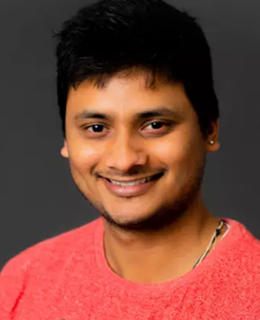

Aditya Nittala
Positions
Assistant Professor
Contact information
Background
Educational Background
PhD Computer Science, Saarland University, 2022
MSc Computer Science, University of Calgary, 2016
B.Eng Computer Science and Engineering, Visvesvaraya Technological University (VTU), India, 2010
Biography
My research vision is to enable the seamless integration of interactive computing devices into our daily environment. My research group is actively working on developing novel technologies that bring computing and interactivity closer to the user’s body. Specifically, we envision a new computing paradigm: Epidermal Computing, which is enabled through Epidermal Devices: devices that reside on the human epidermis. Epidermal Devices are soft, ultra-slim, adapt themselves to the complex geometries of the body, and enable a wide range of expressive interactions. We also create computational design tools to aid the fabrication of these devices. Our research is interdisciplinary and we blend diverse disciplines (e.g. Materials Science, Electrical Engineering, Digital Fabrication, Printed Electronics, and Human-Computer Interaction) for solving fundamental research problems. Previously, I received my MSc degree in Computer Science from the University of Calgary in Canada where I worked on designing and building novel interaction techniques for mobile devices and Mobile Augmented Reality.
Projects
Research areas
Human-Computer Interaction (HCI)
Ubiquitous Computing
Research interests
Wearables
Digital Fabrication
Interaction Techniques and Devices
Teaching interests
Human-Computer Interaction
Interactive Systems
Research Methods in HCI
Physical Computing
Interactive Skin
Awards
- People's Choice Best Demo Award, ACM CHI. 2023
- Best Paper Award, ACM UIST. 2022
- Best Paper Award, ACM UIST. 2019
- Best Paper Honorable Mention Award, ACM CHI. 2019
Publications
In the News
- University of Calgary lab looks 50 years into the future. CTV. (2025)
- Robot vacuums 'could water plants or play with cat'. BBC. (2025)
- Like a Second Skin?. Device Med. (2019)
- TipText Lets You Enter Text Using Thumb-Tip Gestures. Hackster.IO. (2019)
- Multitouch 'skin' makes your body the controller. Engadget. (2018)
- Log on using your Tattoo, say Scientists. The Times. (2017)
More Information
Publications
- Nittala, A.S., Karrenbauer, A., Khan, A., Kraus, T. and Steimle, J., 2021. Computational design and optimization of electro-physiological sensors. Nature communications, 12(1), pp.1-14.
- Nittala, A.S., Khan, A., Kruttwig, K., Kraus, T. and Steimle, J., 2020, April. PhysioSkin: rapid fabrication of skin-conformal physiological interfaces. In Proceedings of the 2020 CHI Conference on Human Factors in Computing Systems (pp. 1-10).
- Nittala, A.S., Kruttwig, K., Lee, J., Bennewitz, R., Arzt, E. and Steimle, J., 2019, May. Like a second skin: Understanding how epidermal devices affect human tactile perception. In Proceedings of the 2019 CHI Conference on Human Factors in Computing Systems (pp. 1-16).
- Nittala, A.S., Withana, A., Pourjafarian, N. and Steimle, J., 2018, April. Multi-touch skin: A thin and flexible multi-touch sensor for on-skin input. In Proceedings of the 2018 CHI Conference on Human Factors in Computing Systems (pp. 1-12).
- Nittala, A.S., and Steimle, J., 2022, April. Next Steps in Epidermal Computing: Opportunities and Challenges for Soft On-Skin Devices thin and flexible multi-touch sensor for on-skin input. In Proceedings of the 2022 CHI Conference on Human Factors in Computing Systems.
- Weigel, M., Nittala, A.S., Olwal, A. and Steimle, J., 2017, May. Skinmarks: Enabling interactions on body landmarks using conformal skin electronics. In proceedings of the 2017 CHI Conference on Human Factors in Computing Systems (pp. 3095-3105).
Are you the profile owner?
Login to edit.
